Q2 2014 Sleep Survey
Sleep Survey: Learning New Steps
Our Second Quarter Sleep Survey shows market place shakeups mean providers are re-learning how they can hustle in a changing marketplace.
- By Joseph Duffy
- Aug 01, 2014
 When looking at the sleep market over both the recent past and the near future, it’s clear to see that sleep providers are in some ways having to relearn a market they used to know like the backs of their hands. They expect volume growth, but feel there are factors hindering that growth. Meanwhile, they’re coming up with ways to drive more revenue from the business to fight reimbursement cuts.
When looking at the sleep market over both the recent past and the near future, it’s clear to see that sleep providers are in some ways having to relearn a market they used to know like the backs of their hands. They expect volume growth, but feel there are factors hindering that growth. Meanwhile, they’re coming up with ways to drive more revenue from the business to fight reimbursement cuts.
According to the 2Q14 HME Sleep Survey conducted by HMEB’s Respiratory & Sleep Management and Needham & Company, sleep patient volume growth is expected to increase while product prices have continued to decline because of competitive bidding.
Sleep patient volume growth
Survey respondents on average reported seeing their sleep patient volume grow by 2.8 percent in the last 12 months and predict that their sleep patient volume will grow by 7 percent in the next 12 months. Of the respondents, 25 percent reported a decline in their sleep patient volume in the last 12 months and 16 percent expect a decline in the next 12 months.
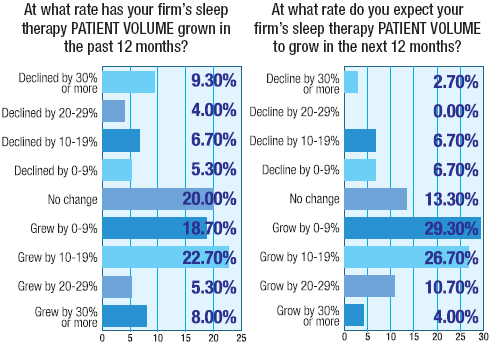
As the U.S. economy continues its recovery, respondents say they believe that the economy is barely creating a drag on their sleep patient volume growth. On average, respondents expect the domestic economy to reduce their sleep revenue by 0.1 percent over the next 12 months, according to the survey.
Resupply Sales
To drive resupply sales, 82 percent of respondents said that they actively follow-up with their sleep patients. The most common methods for follow-up include:
- Live phone calls (used by 70 percent of respondents)
- Automated calls (used by 42 percent of respondents)
- Email (used by 27 percent of respondents)
- Regular mail (used by 22 percent of respondents)
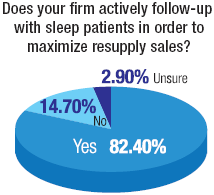
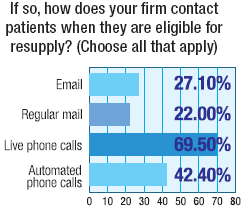
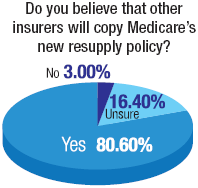
Respondents expect Medicare’s new resupply policy change to be an impediment to growth. On average, respondents report having seen a 6.6 percent reduction to Medicare sleep resupply sales versus a 2.4 percent reduction reported in the 4Q13 HME Sleep Survey.
This translates into an estimated 1.7 percent reduction in U.S. mask and accessory market growth, but 81 percent of respondents expect other insurers to copy Medicare’s new resupply policies, so the overall impact could increase going forward, the survey explains.
There is also an expectation that mask use will increase. Respondents said that patients used an average of 1.88 masks per year in the last 12 months and expect that use to climb to 1.97 masks per year over the next 12 months.
This could increase mask market growth by 4 percent to 5 percent, but as patients are now using almost two masks per year, the effect of increased replacement rates is probably slightly diminishing since we estimate this measure will max out at around 2.5 masks per year. (That’s based on two masks per year for privately insured patients x 75 percent of payer mix + four masks per year for Medicare patients x 25 percent of payer mix = 2.5 masks per year.)
Round Two Bid Winners
Of all survey respondents, only 9 percent said their company won a bid during competitive bidding Round Two, which is down from 20 percent in the Q413 HME Survey. Of those respondents that won bids, the most popular strategy to offset reimbursement declines is to negotiate lower prices with CPAP manufacturers. And this strategy seems to be having some success, as the respondents indicated that all three of the major manufacturers had reduced prices in the last three months in response to bidding.
Using a scale of 1 (very unimportant) to 7 (very important), respondents were asked to rate the following strategies for dealing with lower reimbursement in Round Two:
- Giving Medicare patients less featured (lower cost) CPAPs/masks from existing manufacturers (3.6 average score)
- Switching to lower-priced CPAP manufactures (3.5 average score)
- Giving Medicare patients less featured (lower cost) CPAPs/masks from new manufacturers (3.3 average score)
Respondents also said that commercial insurers have reduced reimbursement as a result of competitive bidding. On average, respondents reported seeing 13 percent of insurers respond with reimbursement cuts.
This corroborates anecdotal reports that private insurers have been cutting reimbursement rates, according to the survey.
A majority of respondents (60 percent) also indicated that they have been able to identify Medicare sleep patients that were previously being serviced by HMEs that did not win round two contracts.
While the survey did not ask how they have obtained this information, it is possible that HMEs that lost have been providing patient lists to the HMEs that won contracts, the survey reports.
Auto-setting and Bi-level Flow Generators
According to respondents, 40 percent of their patients use auto-setting flow generators, which will likely grow to about 41 percent of patients over the next 12 months. Auto-setting flow generators sell for a premium to standard flow generators and can drive positive or negative mix shifts.
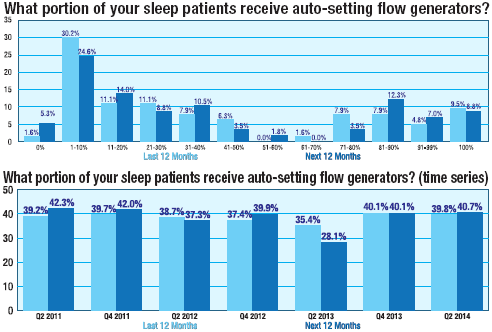
Survey respondents said that 11 percent of patients use bi-level flow generators, which looks likely to increase to 13 percent of patients in the next 12 months. Bi-level flow generators also sell for a premium to standard flow generators and as a result we expect increasing use to drive a positive mix shift.
Flow Generator Price Declines
One thing the survey shows definitively is that flow generator price declines are, again, the worst in the history of our survey.
Respondents indicate that flow generator prices declined by 5.4 percent in the last 12 months versus a 3.6 percent decline in the 4Q13 HME Survey. This represents the largest decline seen in any of these surveys over the past eight years and indicates that flow generator price declines have worsened from prior surveys, most likely as a result of competitive bidding.
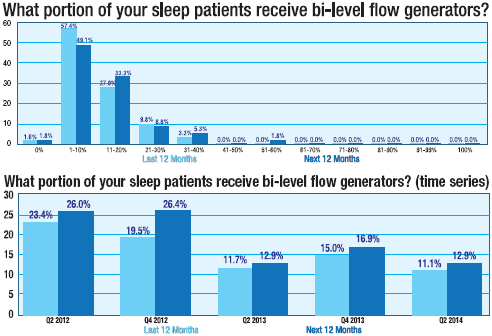
Suffice it to say that providers have as many questions about the sleep market as they have answers for our recent survey. Without a doubt the market has seen some game changing impacts from factors such as competitive bidding and the economic recovery, but the growth potential of multitudes of yet-to-be-diagnosed OSA patients makes it clear the market potential and growth are there — and providers are shaping new strategies to tap into it.
This article originally appeared in the August 2014 Respiratory & Sleep Management issue of HME Business.
About the Author
Joseph Duffy is a freelance writer and marketing consultant, and a regular contributor to HME Business and DME Pharmacy. He can be reached via e-mail at [email protected].